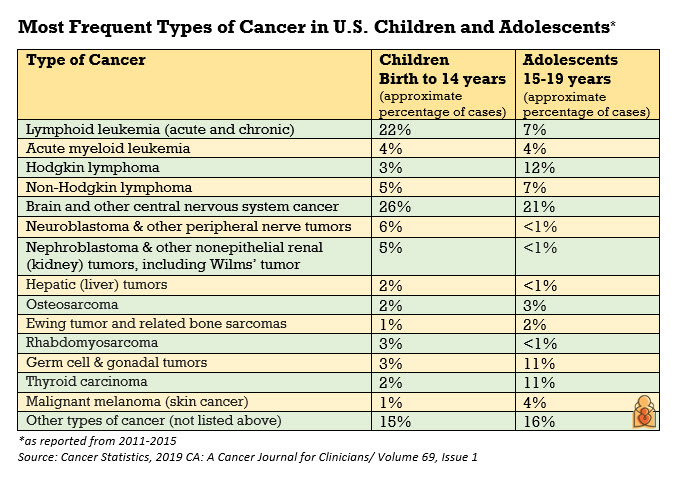By: Stephanie Savelli, MD, FAAP & Pinki Prasad, MD, FAAP
Childhood cancer is rare. For children born in the United States, 1 in 285 will be
diagnosed with cancer before they reach age 20.
Advances in treatment have increased survival for many children. However, cancer remains the second leading cause of death in children ages
1 to 14, after unintentional injuries.
What are the most common cancers in children and adolescents?
Overall for children and adolescents (ages 0 to 19) in the United States, the most common types of cancers are
leukemias, which are cancers of the blood or bone marrow cells; brain and
central nervous system tumors, including cancers of the spine; and
lymphomas, which are cancers of the lymph nodes or glands). However, the types of cancer can vary by age.

Leukemia
Leukemia, a cancer of the bone marrow cells, is the of the most common types of childhood cancers. The bone marrow is the core or soft center of the long bones of the body where white blood cells, red blood cells, and platelets are produced. White blood cells (called leukocytes) help fight against infection. Red blood cells carry oxygen for the body. Platelets help the body stop bleeding when it is injured.
In children with leukemia, the bone marrow produces a lot of abnormal, immature white cells that are unable to fight
infection. Eventually these leukemia cells crowd out the healthy white blood cells, allowing viruses, bacteria and other microorganisms to infect the body and make a person sick. Leukemia cells also crowd out the red blood cells and platelets, making it hard for the body to get enough oxygen and stop bleeding after an injury.
Types of leukemia include:
Acute lymphoid leukemia (ALL) – Roughly three-quarters of all childhood leukemias are ALL, which involves abnormal growth of a type of immature white blood cell called lymphoblasts.
Acute myeloid leukemia (AML) - Abnormal growth of another type of white blood cell called myeloblasts and monoblasts.
Because leukemia cells leave the bone marrow and enter the bloodstream, which goes everywhere in the body, leukemia is a systemic disease. Leukemia can spread to blood vessels in the brain and spinal cord, the testicles, the ovaries, the kidneys and other organs.
Lymphoma
Lymphoma is a cancer of the immune system, affecting lymphoid tissues (lymph nodes and other glands through the body, like the tonsils or thymus). Lymphoma cells, abnormal, immature white blood cells that can't fight infection, end up crowding out the normal lymphoid tissue. This leaves the nodes or glands unable to defend the body against foreign invaders like viruses.
Lymphoma cells can also be found in the bone marrow and other organs of the body such as the liver or the spleen. Lymphoma can cause different symptoms, depending on where the cancer is.
Types of lymphomas include:
Hodgkin disease (or Hodgkin lymphoma) - Usually presents and progresses with gradual, persistent signs and symptoms such as fatigue, fever, and weight loss.
Non-Hodgkin lymphoma - Signs and symptoms depend on the type of non-Hodgkin lymphoma, but usually appear and progress more rapidly than Hodgkin lymphoma.
The three major types are called lymphoblastic lymphoma, mature B-cell lymphoma, and anaplastic large cell lymphoma.
The different subtypes are treated in different ways.
Brain cancers (and other central nervous system cancers)
There are many types of brain and spinal tumors or cancers of the central nervous system, and the treatments are different. Brain and spine cancers arise from an abnormal growth of immature nerve or supportive cells in in the brain or spine. These abnormal cells take up space in the brain or spinal cord and can disrupt normal movement, sensation, thought and/or behavior.
There are four common groups of childhood and adolescent brain cancers or tumors depending on the types of cancer cells involved.
Astrocytomas - Arise from astrocytes or supportive tissue of the brain. They may be either low-grade which grow slowly and rarely spread to other parts of the brain, or high-grade which are more aggressive and can spread to other parts of the brain and the spinal cord.
Primitive neuroectodermal tumors - Arise from primitive nerve cells and are more common in children than in adolescents.
Brain-stem gliomas - Arise in the bundle of nerve tissue at the base of the brain, where crucial functions such as heart rate, breathing, and swallowing are controlled
Ependymomas - Usually arise in the lining of the brain's ventricles, the four connected pockets within the brain. The ventricles produce the cerebrospinal fluid that surrounds and cushions the brain and the spinal cord. If an ependymoma is present, the fluid often sends the cancer cells around the brain and spine.
Rhabdomyosarcoma
Rhabdomyosarcoma is a cancer from abnormal growth of immature muscle cells. This can cause swelling, which may or not be painful, and interfere with normal body function as it grows in the head and neck, groin, abdomen, pelvis, or in the arm or leg. When rhabdomyosarcoma spreads, it typically goes to the lymph nodes, bone, bone marrow, or lung.
There are two main types of pediatric rhabdomyosarcoma:
Alveolar rhabdomyosarcoma - Is more likely seen in teenagers and involves most commonly large muscles of the trunk, arms, and legs (but can be seen in other places as well)
Embryonal rhabdomyosarcoma - Is more common in infants and young children and occurs most commonly in the head and neck, bladder, prostate, testicles, and vagina
Neuroblastoma
Neuroblastoma is a cancer that starts with abnormal growth of immature nerve cells, most often arising in the adrenal gland (an organ that makes hormones, located outside the kidneys). It can also form in nerve tissue along the spine near the neck, chest or abdomen. These abnormal cells can disrupt the normal function of the affected body areas and can spread to the skin, bone marrow, bones, lymph nodes, and liver.
Nephroblastoma (Wilms Tumor)
Wilms tumor, or nephroblastoma, is the most common type of pediatric renal (kidney) cancer. It most often affects children between 2 and 5 years old. This cancer arises from an abnormal growth of immature kidney cells, often causing a mass on the child's abdomen and disrupting kidney function. This cancer can spread to the lungs, liver, bone, brain or lymph nodes.
Thyroid cancer
Thyroid carcinoma (cancer) is an abnormal growth of immature thyroid tissue, developing as a lump or lumps in the butterfly-shaped gland in the middle of the neck. This cancer disrupts the normal hormone production of the thyroid, which controls metabolism, hart rate, blood pressure, and body temperature. Thyroid cancer can spread into areas of the neck or to lymph nodes, lungs, bone, or sometimes the brain.
Bone Cancer
Primary bone cancers (cancers that start in the bones) occur most often in older children and teens, but they can develop at any age. These cancers form painful lumps on the bone(s), interfering with normal bone growth and stability. Primary bone cancers may spread to the lungs, as well as to other bones and soft tissue. Primary bone cancer is different from metastatic bone cancer, which is abnormal growth of immature cells from non-bone cells elsewhere in the body that then spread to the bones.
Two main types of primary bone cancers occur in children:
Osteosarcoma - Often arises during the growth spurt of puberty and about half of these bone cancers develop in the region of the knee.
Ewing sarcoma - Is a less common type of bone cancer which occurs most commonly in the pelvic (hip) bones, ribs, shoulder blades, and upper legs and arms.
Germ Cell & Gonadal Tumors
Germ cell tumors come from an abnormal growth of immature cells that would normally develop into the reproductive eggs in girls and sperm in boys. Roughly 90% of germ cell tumors begin in the reproductive cells of the gonads (testes or ovaries), leading to lumps or abnormal hormonal changes. Some of these cancer growths can arise as lumps in the abdomen, brain, or chest. These can spread to the lymph nodes, lungs, liver, and brain.
What causes childhood and adolescent cancer?
The causes of most childhood and adolescent cancers are largely unknown. The cancers that children and teenagers get are not considered preventable or contagious.
A small number of childhood cancers can be related to Down syndrome (Trisomy 21), or other inherited genetic abnormalities called mutations. Rarely, exposure to excessive radiation or environmental chemicals have been associated with childhood cancer but these risk factors are too difficult to confirm.
Have the treatments and survival rates for childhood and adolescent cancer improved?
Prompt and thorough evaluation for the type of cancer is important, because different types of cancers are treated differently. Childhood and adolescent cancers are usually treated at a children's hospital by doctors specializing in pediatric cancers. These doctors are pediatric oncologists.
With better testing to determine the specific types of cancers and better treatments available, cancers of childhood and adolescents are more
curable today than in the past. Overall survival rates in childhood and adolescent cancer are now approaching up to 90%for many cancer types as a result of participation in
clinical trials and specialized medical care at pediatric and adolescent cancer centers.
Additional Information:
About Dr. Savelli:
 Stephanie Savelli, MD, FAAP, is the Director of the Childhood Cancer Survivorship and Late Effects Program and Pediatric Hematology-Oncology Fellowship Program at Akron Children's Hospital. Within the American Academy of Pediatrics, she is a member of the Section on Hematology and Oncology Education Subcommittee and the Coagulation Disorders Review Group.
Stephanie Savelli, MD, FAAP, is the Director of the Childhood Cancer Survivorship and Late Effects Program and Pediatric Hematology-Oncology Fellowship Program at Akron Children's Hospital. Within the American Academy of Pediatrics, she is a member of the Section on Hematology and Oncology Education Subcommittee and the Coagulation Disorders Review Group.
About Dr. Prasad:
 Pinki Prasad, MD, FAAP, is a hematology and oncology specialist at Children's Hospital New Orleans and an Associate Professor of Pediatrics at Louisiana State University School of Medicine. She received her medical degree from the University of Saint Eustatius in Saint Maarten and completed her residency training at Southern Illinois University in Springfield, Illinois. She then completed a fellowship in Pediatric Hematology and Oncology at Vanderbilt University Medical Center in Nashville. Within the American Academy of Pediatrics, she is a member of the Section on Hematology and Oncology.
Pinki Prasad, MD, FAAP, is a hematology and oncology specialist at Children's Hospital New Orleans and an Associate Professor of Pediatrics at Louisiana State University School of Medicine. She received her medical degree from the University of Saint Eustatius in Saint Maarten and completed her residency training at Southern Illinois University in Springfield, Illinois. She then completed a fellowship in Pediatric Hematology and Oncology at Vanderbilt University Medical Center in Nashville. Within the American Academy of Pediatrics, she is a member of the Section on Hematology and Oncology.